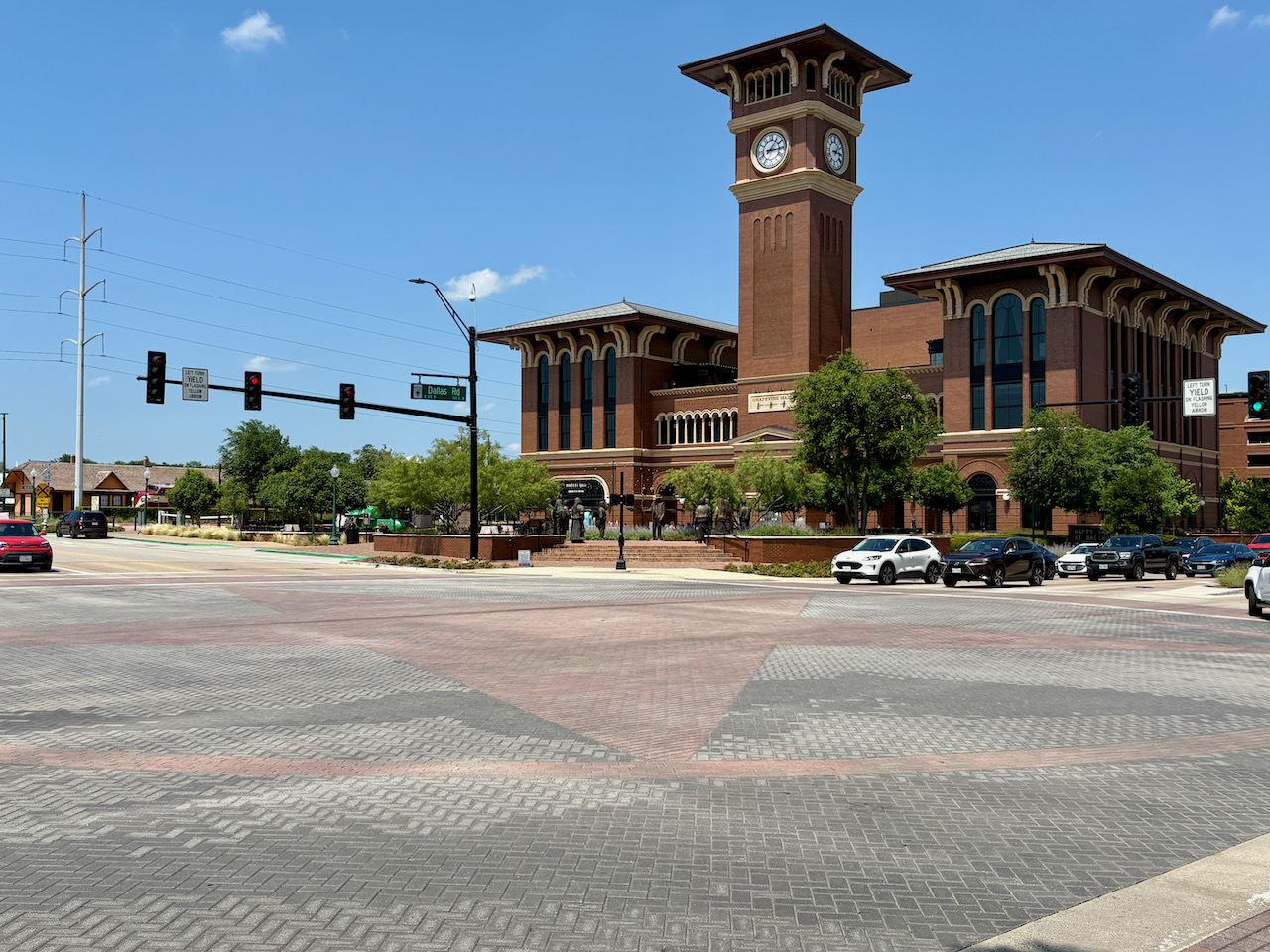Grapevine Main was Built to Feel Like Home, Just More Exciting

2 Jun 2025
Blog, News, 2025
A few years ago, driving into Grapevine’s Historic District was fairly routine. One might pass the same collection of retailers, residences, and small businesses on offer anywhere in the suburbs of DFW before arriving, without much warning, in the charming historic district that stands out as the geographic and spiritual heart of this City. Main Street has always been special, but travelers were as likely to stumble into it as discover it with a sense of wonder. It took decades of planning and some painstaking design to change that, with one iconic project providing the foundation.
Completed with the grand opening of a European-style food hall offering half a dozen eclectic menus in February 2021, the combination hotel/train station/restaurant/public gathering space known as Grapevine Main rose to prominence among a crowd of landmarks in a community known for hospitality and destination entertainment. Through careful planning and intentional design, local leaders transformed an underutilized parcel of land into a true gateway project that earned recognition in multiple Best of DFW lists, graced the cover of D Magazine, and received a Great Places in Texas designation from the American Planning Association.
Monumental achievements in every sense, born from a passion for historic preservation and a desire to grow in a way that honors the past. Now, we’re asking a group of City staff and elected leaders how it came to be.
Looking Back to Plan Ahead

Only a few blocks of Historic Main Street date back to the turn of the twentieth century, but great pains have been taken to preserve properties from the early years of Grapevine history. Longstanding buildings have been modernized for their protection, while newer builds like the 600 block, City Hall, and the Convention & Visitor’s Bureau Headquarters were crafted to match with help from Architexas. As a result, the neighborhood feels like a cohesive whole even though it came together in pieces.
“Our downtown is authentic. It is not something that has been built in the last twenty or thirty years,” said Sharron Rogers, City Council Place 2. “When you see an old building, it’s old. Or it’s a replica of buildings that were here in the 40s and 50s but were torn down in the name of progress, like the Wallis Hotel that now is home to Messina Hoff.”
The same idea was applied to a parcel of land at the southern end of the Historic District, purchased by the City decades ago. While the buildings on that plot were historic to a degree, they did little to enhance the sense of place that makes Main Street a potent draw for visitors and families. Community leaders decided they could do more to evolve the area without sacrificing its overall charm.
“We bought that land, I don’t know, maybe twenty years ago,” said former Mayor Pro Tem Darlene Freed. “It was always just sort of held because that’s where the train tracks came through. So there was always this vision that there would be something in the future.”
“Fortunately for us, the real estate was – in terms of the physical facilities – not great,” added City Manager Bruno Rumbelow. “They probably were looking to move somewhere else in order to have a better building. There was a kind of coming together, even at that time, of intent and good fortune. That made it such that we were able to secure that property at a price we could agree to, remove that building, and clear the land.
“It took a little bit of time for that vision to come together, but once it did, you can see, it's just an amazing development. Something people are going to be proud of here for decades to come... a community gem and maybe one of the best public-private partnerships in the state.”
Designing a Gateway in the Middle of a Destination
When planning a city and designing its landmarks, it’s common practice to develop a few “gateway projects,” recognizable signs and structures that communicate a change of place as travelers approach. Famous examples, like the Gateway Arch in St. Louis, stand near a boundary line, helping to signal arrivals and departures while creating the sense that a location is unique and distinct from the space around it. Thanks to the railroad system cutting through the center of town and a development pattern once used to draw an agrarian society together, however, Grapevine’s most recognizable neighborhood stands far from any meaningful border. These days, a large portion of visitors cross into Grapevine without realizing it and step into the community only after reaching its geographic center.

When the community opened its first passenger rail stations in 2019 – two within the boundaries of DFW International Airport and another on Main Street – the City Council wanted to exceed the requirements for a standard station. Rather than building a simple platform with automated ticketing, they launched a research campaign that would culminate in multiple bids for a public-private partnership.
The development known as Grapevine Main began there.
"We did a lot of road trips and looked at a lot of different facilities to see what we really wanted here in Grapevine. And I must admit, there was a difference of opinion in the various Council members and the Mayor,” said Duff O’Dell, City Council Place 6. “But at the end of the day, we had a vision of wanting to preserve the heritage of Grapevine through new building. I think we really knocked it out of the ballpark.”
To facilitate development, Grapevine’s City Council adopted an optional Transit District Overlay: special guidelines that prescribe aesthetic components for new construction within a strategic area south of the Historic District. The document allows developers to adopt design elements from across the historic district in exchange for greater flexibility with regard to end users.
In short: you can do more in downtown Grapevine if you build to match the established atmosphere.

“Our historic main street has this wonderful vibe to it, whether it kind of harkens back to history or whether it’s because some of the programming we have is contemporary,” said Kathy Nelson, a Planning Manager within the City’s Parks and Recreation Department. “It’s a mish-mash of the two coming together to create a wonderful experience – it's just trying to increase the levels of peoples’ curiosity, I think.
“You have this huge tower that people can see from all over, but once you get closer you see this big plaza. What’s going on there? I don’t know; it’s still kind of big, so let’s create some more cues. There was a purpose for putting Peace Plaza there at the corner: to bring that scale down to pedestrians from a multistory tower that’s really high, to the expansive plaza, down to something I can grasp and see and am interested in.”
In that way, the tower atop the City’s newest landmark building serves as a lightning rod for visitor interest: large enough to capture the attention of passersby and funnel it toward the ground without dominating the area around it. Yes, the clock matches another within the Historic District and the entire project is covered in iconic red brick. But those aren’t the only details working to create a sense of connection and comfort. A brick inlay in the shape of a massive Texas star fills the nearest intersection. Bronze statues and expanded sidewalks enhance the pedestrian experience, too; making Grapevine Main a perfect introduction to the area for families who decide to leave the car behind and take advantage of the walkability upgrades in the area.
Activating a New Era
In the world of Urban Design, the use of practical building elements to spur social behaviors is called “Placemaking.” You’ve probably experienced it as the draw of a lively crowd in an open space or the sense that your afternoon would be so much better if you could just sit in that special alcove that seems to have been built just for you. Placemaking deals with large areas and ideas, but it often comes down to little details. And in Grapevine, it’s almost always enhanced by events and programming overseen by City staff or our private partners.
“Creating and enhancing our public spaces because we are trying to promote community well-being and facilitate more social interaction and a sense of belonging in our communities, that is the purpose of placemaking,” said Erica Marohnic, the City’s Director of Planning. “What we’ve seen a lot, between spaces that are planned and maintained by our Parks and Recreation Department or Convention and Visitor’s Bureau, is they’re preserving what had historically been there or relocating a structure that has historical significance... and then doing some type of programming around that throughout the year.

“Main Street is historic because it’s old. But it happened organically, and it changed over time to become more auto-oriented. It’s coming back around. The Transit District is meant to complement what happened on Main Street, but really do it better. It’s not exactly the same, it’s not exactly the same uses, but we can program in there and incentivize a form of development that will be more pedestrian oriented and allow for activity; for public gathering spaces, for wider sidewalks, for buildings that come up to the sidewalk instead of having a sea of parking between the right of way and the building... if anything, it’s like ‘if we could re-do Main Street, how would we formulate the regulations to make it the best it possibly could be?’”
The answer, at least in part, was to create a public-private partnership on a scale Main Street had never seen before. By leveraging a combination of Tax Increment Financing, regional grant funds, and private capital, the City found a way to add parking capacity, a six-story boutique hotel, public transportation, and social programming to a Historic District that had previously been supplied with small-scale retail and restaurants. What’s more, the new things feel seamlessly integrated with the historic ones.
In the months ahead, we’ll take a closer look at the partners who made this project possible. But for now, we encourage you to spend a little extra time looking for the special details that make Grapevine Main so unassumingly spectacular.
For a more in-depth understanding of this project, check out ‘Growing Grapevine’ on Spotify, Apple Podcasts, or your favorite audio streaming service. You can also subscribe to our monthly newsletter or find us on Facebook and LinkedIn to stay up to date on major developments around the City.
More Topics

The Quest for Logistics Supremacy
Jun 2 2025






